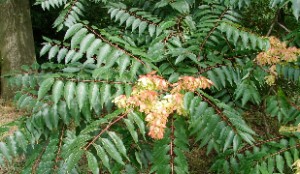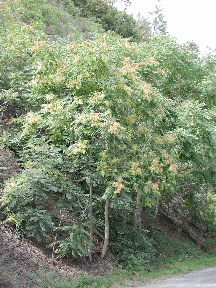Tree-Of-Heaven
Ailanthus altissima
Tree-of-Heaven
Common Names: Stinking sumac, Chinese Sumac, Copal Tree, Ghetto Palm
Native Origin: Eastern & Central China.
Description: Tree-of-Heaven is a rapidly growing deciduous tree that can reach 80 feet or more in height. It has smooth stems with pale gray bark, light brown twigs, and large compound leaves — up to three feet in length with as many as 25 leaflets. Small yellow-green flowers in dense clusters near the ends of upper stems are followed by pink to tan colored winged seed-containing fruits (samaras). All parts of the tree, especially the flowers, have an offensive odor, likened by some to cat urine or rotting peanuts.
Ecological Impacts: Brought to the United States via England by a Pennsylvania farmer in 1751, Tree-of-Heaven probably has not been purposefully planted for at least a century, but now occurs nearly throughout the U.S. A prolific seeder (up to 300,000 seeds per tree), it also spreads through numerous root suckers and re-sprouts from cut stumps and root fragments. Once established, Tree-of-Heaven can quickly take over a site and form an impenetrable thicket. The trees, and even remaining roots, produce toxins that inhibit the growth of other species. Both the sap and leaves of Tree-of-Heaven may cause poison-ivy-like skin irritation in some persons.
Similar species: Take care not to confuse Tree-of-Heaven with native sumacs or walnuts, which do not have the offensive odor and do not have winged fruits (samaras).
Control & Management: This is a difficult species to eradicate, and it may require several methods over several years. Cutting down large trees will reduce spread by seeding, but will encourage re-growth through suckering and stump sprouting.
Manual: Young seedlings may be pulled up, preferably when the soil is moist. Care should be taken to remove the entire plant as even root fragments may re-sprout.
Chemical: General-use herbicides, such as triclopyr (Garlon) have been effective. Herbicide can be applied as foliar spray, basal bark, cut stump, or wound-and-squirt methods. The wound and squirt method, or basal spray methods both have been most effective, as wounding the tree, rather than immediately killing it, seems to reduce suckering. However, large trees may still produce seed crops. Basal bark application is most effective in late winter/early spring and summer; hack-and-squirt method minimizes sprouting when performed during the summer.
Biocontrol: The USDA and other agencies continue research on several fungal pathogens isolated from dead and dying ailanthus trees in New York and Virginia.
Comments are currently closed.




[…] For information on control and management, please visit Clifftop’s website: http://www.clifftopalliance.org/2011/08/tree-of-heaven/. […]
seo guidelines 2017 pdf
qtvpywjty vdsnf xmywfpw wtle agqudbeuralneun